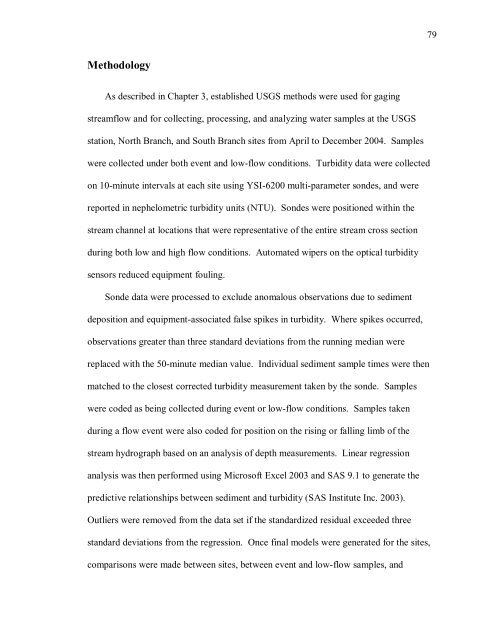CHAPTER 4 – ESTABLISHING A RELATIONSHIP BETWEEN ...
CHAPTER 4 – ESTABLISHING A RELATIONSHIP BETWEEN ...
CHAPTER 4 – ESTABLISHING A RELATIONSHIP BETWEEN ...
You also want an ePaper? Increase the reach of your titles
YUMPU automatically turns print PDFs into web optimized ePapers that Google loves.
79MethodologyAs described in Chapter 3, established USGS methods were used for gagingstreamflow and for collecting, processing, and analyzing water samples at the USGSstation, North Branch, and South Branch sites from April to December 2004. Sampleswere collected under both event and low-flow conditions. Turbidity data were collectedon 10-minute intervals at each site using YSI-6200 multi-parameter sondes, and werereported in nephelometric turbidity units (NTU). Sondes were positioned within thestream channel at locations that were representative of the entire stream cross sectionduring both low and high flow conditions. Automated wipers on the optical turbiditysensors reduced equipment fouling.Sonde data were processed to exclude anomalous observations due to sedimentdeposition and equipment-associated false spikes in turbidity. Where spikes occurred,observations greater than three standard deviations from the running median werereplaced with the 50-minute median value. Individual sediment sample times were thenmatched to the closest corrected turbidity measurement taken by the sonde. Sampleswere coded as being collected during event or low-flow conditions. Samples takenduring a flow event were also coded for position on the rising or falling limb of thestream hydrograph based on an analysis of depth measurements. Linear regressionanalysis was then performed using Microsoft Excel 2003 and SAS 9.1 to generate thepredictive relationships between sediment and turbidity (SAS Institute Inc. 2003).Outliers were removed from the data set if the standardized residual exceeded threestandard deviations from the regression. Once final models were generated for the sites,comparisons were made between sites, between event and low-flow samples, and
















